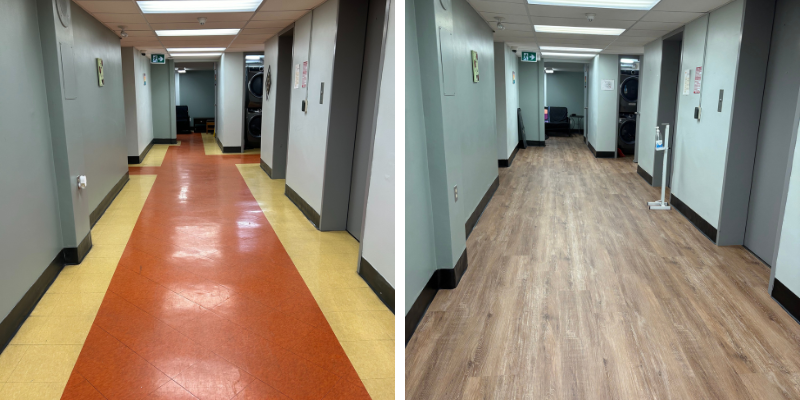Now this Hamilton woman has an apartment of her own
“Everybody’s trying to get me to write a book,” Heather Grant says.
“My dogs love it out there,” Grant says about the balcony as Dino, one of her three pooches, sits on her bed in the small but bright unit.
But after a year of homelessness, she mostly gushes about another fixture of everyday living that many take for granted.
“Now that I’ve got my bathtub, I’m in there all the time,” Grant says, noting she’d kept clean with sanitary wipes before she lined up housing.
The emotional scars of living first in a tent, then an old RV at a city-owned brownfield off Barton Street West near the CN rail yard don’t wash off easily.
One cold February morning, Grant found her husband, Tim, dead in the trailer.

Teviah Moro Spectator file photo
The 67-year-old had been in and out of hospital several times, including for dialysis treatment and other ailments, during their time on the barren site.
“I’m up at 5 o’clock every morning — the time that my husband passed,” says Grant, 65, as Dino wanders around the small apartment.
The other small dogs, Angel and Button, are in the bathroom to keep from barking during The Spectator’s visit.
Grant says she’s grateful to have housing, and credits social-service agency Wesley for lining it up for her and ongoing support as she gets settled.
But it’s not without bitterness that she views a $7-million city plan to locate 40 cabinlike shelters with services, including showers and toilets, on the Barton West land, where she toiled for so long.
“I fought for a year to get that done, and they wouldn’t do it, and now they’re doing it,” says Grant, speculating the services may have lightened the toll on her husband.

‘Before the snow falls’
The plan for 40 cabins for as many as 80 people, along with an array of support services, is one element of an $18.3-million overall effort to get people indoors this winter.
In parallel, the city is working with social-service agencies to add 192 more shelter beds and transitional spaces to the system, bringing the system’s total capacity to 533 in coming weeks.
The temporary boost is meant to fill in the gap while city staff explore a permanent expansion through shelter operators and until Hamilton can shore up its stock of affordable and supportive housing.
The plan springs from a directive Mayor Andrea Horwath issued to staff in August to draft a plan for an alternative to encampments in city parks and other urban spaces across Hamilton.
“I’m hoping before the snow falls we can provide that space for people,” Horwath said in September after staff presented the proposal to council.

Cathie Coward The Hamilton Spectator
Roughly 1,600 people are homeless in Hamilton, and of those, around 300 are known to live outside.
It’s a problem city officials attribute to a slew of factors, including unhelpful provincial rental policies, lagging social-assistance rates and inadequate support from upper levels of government for housing.
Meanwhile, tents in parks, permitted under a municipal encampment protocol, are the source of rising community tension as residents and business operators who live and work near them raise complaints at city hall.
With the creation of the “sanctioned” site on the Barton land, council has agreed to make nearby Bayfront, Pier 4 and Central parks no-go zones for encampments — a process city staff say won’t happen overnight.
Still, there’s opposition to the outdoor shelter plan, with some residents who live in the area saying they were given “insufficient time” to offer feedback before council adopted it.
“Concerned residents who live nearby were not afforded this opportunity; impacted residents deserve to have a choice,” Kelly Oucharek wrote in an email to city officials advising them of a community meeting on Oct. 21.
The city aims to seek community feedback on the plan, says Al Fletcher, the city’s acting director of housing services, but for the moment staff are “focused on the end goal” of preparing the site.
That includes contract talks with a potential supplier of the cabins of the Barton land, where people still reside in campers, tents and other makeshift shelters.
“Over the past month or so staff have done a pretty exhaustive search as to what is available out there,” said Fletcher, who wouldn’t name the would-be supplier amid ongoing negotiations.
Talks with a potential operator for the managed site are also ongoing, he said. Last month, staff noted Good Shepherd had offered its expertise to lead the project with other agencies expected to play roles.
The city is also working on an additional site for non-profit Hamilton Alliance for Tiny Shelters (HATS), which has aimed to set up a village of 20 to 25 small cabins for about three years.
“We are looking at city-owned lands as the priority, and some of those lands have uses on them right now,” said Fletcher, who didn’t provide specifics.
Hamilton’s foray into outdoor shelters with “wraparound” support services takes a page from projects in other communities, such as A Better Tent City in Kitchener, an early adopter of the model in Ontario.
In Hamilton, the traditional shelter system is chronically at capacity, but some people without housing avoid it for various reasons, including mental-health issues, addiction problems and fear of theft.
Fletcher says the goal is to create a “low-barrier” outdoor site that has rules but removes “some of those obstacles” that people face in shelters.
Not exclusively, but the cabins are prioritized for couples or people with pets, both of whom can’t access shelters without separating from partners or their furry companions.

‘I miss my husband’
Grant faced both of those realities when she and husband Tim wound up at the Barton land last fall, after the city cleared a large encampment at Woodlands Park, where they’d lived in a tent that summer following an eviction.
The couple’s adult son, daughter and grandson also made their way to the former industrial property between Stuart, Caroline and Tiffany streets — a site once eyed for a west end football stadium and more recently a creative arts hub.
At first, they lived in tents, but then moved into the old RVs. Grant points out she bought the one she and her husband lived in for $1,000 and had it towed to the land.
As fall turned to winter, the city handed out notices to those with RVs at the site, saying the illegally parked vehicles had to go. “We can’t go back in a tent. We froze our little butts off the last time,” Grant said last December.
Despite the notices, as well as visits from outreach workers and bylaw officers alike, the Grants stayed put, although their son, also named Tim, found housing later that winter.

Eventually, rats started scratching at their RV, as their three dogs barked at strangers who approached and debris piled up at the camp.
There were also fires, thefts and disputes. All told, it was one of the worst chapters in her life, Grant reflects. “Yeah, everybody’s trying to get me to write a book.”
Fletcher acknowledges finding housing for people living outdoors is tough with Hamilton’s low vacancy rate. “We just to need to work with landlords to make it a successful opportunity.”
In the past year, on average, the city and its partners have managed to house 10 people a month, Fletcher says, but points out it’s not always a straight line, noting the journey can involve shelter stays first.
While she was still in the RV, Grant told The Spectator she’d viewed an apartment but found it too expensive (and too small) for what she received in social assistance.
But this past summer, with the help of a Wesley worker, Grant moved into a bachelor in a private building for a little more than $1,000 a month.
Soon afterward, the CityHousing unit, larger and cheaper at $567 a month, opened up at the Main Street West building just outside downtown, where Grant has lived since September.

Teviah Moro Spectator file photo
(Her daughter and grandson have found rental housing through a work connection of his.)
Grant’s RV is still at the Barton site. If possible, she’d like to sell it and recoup at least some of the $1,000 she spent on it.
But she has been busy getting her new life in order, including settling matters after the death of her spouse of 40 years last winter.
Her son has his ashes, but Grant hopes to have them soon in her new apartment.
“I miss my husband, because he was always there to talk. We had our fights and everything, but we loved each other.”
His wheelchair, parked beside her bed, is a constant reminder of him.
Grant say she uses it to get around because scrap-metal scavengers at the Barton site stripped hers of parts.
“This one, I don’t know how my husband handled it, but it’s haunted,” Grant insists. “When I want to go right, he wants to go left.
“Everybody laughs at me because I go, ‘Tim, smarten up.’ And they just look at me, ‘Who is she talking to?’”



